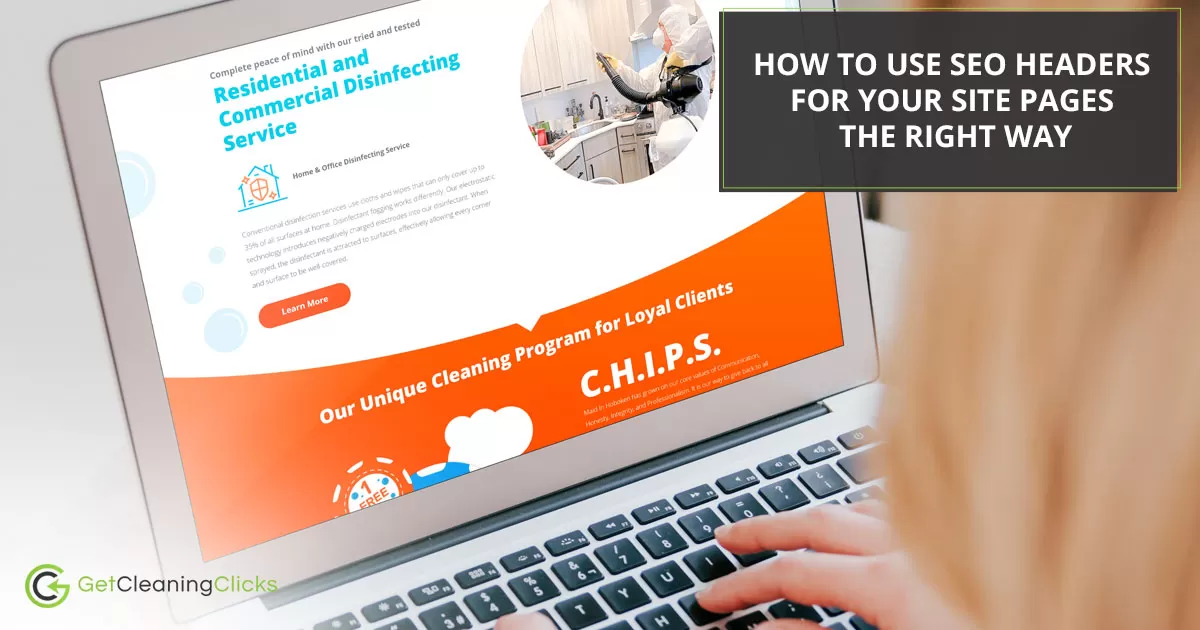Using SEO headers can boost your website’s performance.
And if you want tips on how to make it happen, this article will help you out.
Here we’ll discuss what header tags are and what makes them essential. If you want to improve your cleaning service website’s SEO strategy, it’s how to go.
What are SEO headers?
SEO headers are headings that help emphasize sections of your content. They categorize text and make the sections of your post easier to understand.
Below is a sample image of a web page containing a bunch of headers. It’s taken from Maid in Hoboken’s website, a company that offers cleaning services in Hoboken, New Jersey.
Wondering how you can use these SEO headers when creating content?
Load up a text editor. There, look for the part where you can format a specific text in your outline.
For instance, in WordPress’ classic editor, you can access these headers under Paragraph (in its drop-down menu).
Why using SEO headers is important.
Without a doubt, your cleaning service website needs to adopt SEO for it to succeed. And fortunately, these header tags can help.
They’re HTML elements and thus serve a purpose in your cleaning business’ SEO strategy.
Here’s a look at why a search engine likes header tags:
- Presents relevance – Search engines find the text within these tags to be more valuable and worth prioritizing. Thus, using headers relevant to a query allows search engines to know if it should present your content.
- Make texts scannable – Headers make the text underneath them less challenging to read. For a visitor that wants to scan your post for useful details, scannable texts are important.
- Acknowledges an article’s purpose – Each header supports the rest of the article. It notifies search engines of an article’s purpose.
How to use SEO headers the right way
Notice how each header in the first image above comes in a different size?
That’s because there are different header tags. This means you can assign h1, h2, h3… and so on to the different headlines of your content.
Here’s how you can proceed:
Understand hierarchy
Want to make sure the sections on your web page are in order — and not a mess?
Then observe the proper use of these header tags. H1 goes first, then h2, h3, and so on.
Each heading serves a unique purpose. So, if you don’t follow their supposed order, you will go against that purpose.
Here’s a look at the first set of headings and what they stand for:
- H1 – It should reflect a web page’s key theme. It should also contain primary keywords.
- H2 – Think of h2 tags as section headlines. They should inform visitors what a section is about.
- H3 – It’s a subsection that should break up and organize the content for h2 tags.
Use one h1 tag
H1 tags are big. From a normal point of view, these h1 tags look like titles. They help display the most important text and elaborate on their point in the sections underneath.
The image below will show you an example of an H1 tag from Love My Maids, a company that offers cleaning services in Arlington, Texas.
However, while great and all, don’t overdo it with these tags. Use one h1 tag, and you’re all good.
Assigning multiple h1 tags to your content defeats the purpose of providing clarity in your article.
H1 tags look like titles, right?
So, if you include multiple h1 tags, it’s like you’re including multiple titles in the same article. And that would cancel out the point of having a title.
Outline important sections
If used to provide structure and context, header tags will work to your advantage. So, leverage these headers to help make your content easy to go through.
Remember that not everyone wants to read an article in its entirety. It doesn’t matter if your post is interesting. If a visitor’s intent is to be informed, they want information — and nothing else.
So, here’s how you can assure visitors they’ll get information through header tags:
- Include keywords – Keyword-rich headers serve as trigger words that attract certain visitors to the rest of your content. They can also directly influence your rankings on search results.
- Don’t use long headings – If your visitors can’t spot something useful in your article quickly, they will look for another resource. And if that other resource can pull off the job, these people would much rather check that out.
- Answer user intent – For instance, your visitors are looking for your cleaning business’ contact information. So, make your header reflect that.
Break up texts
Writing walls of text and expecting people to be excited about reading them isn’t advisable. It’s too much to ask for. And it’s the equivalent of asking random visitors to read an academic essay.
Considering they’re looking for a cleaning service, it looks like they want a stress-free time. And stumbling upon a wall of text doesn’t give them that. It gives them a reason to leave.
So, get on people’s good side by presenting small chunks of content, instead. And use header tags to attract these people to check out what you have.
Here’s what you can display underneath your headers to improve your content’s readability:
- Lists – Use bullets and numbers to present brief information.
- Images – They increase the overall visual appeal of a web page. SEO experts can attest to this.
- Short sentences – They make your messages clearer and easier to grasp.
Assign unique headers for unique web pages
Not assigning unique headers to a specific web page creates confusion. This will confuse both search engines and visitors.
It’s like offering unique kinds of cleaning services. If you don’t assign unique headers, it’s like you prefer to give each service the same name.
Below are images of a cleaning service website’s web pages with unique heading tags. It’s from Rain City Maids, a business that offers cleaning services in Kirkland, Washington.
Header for One Time/Deep Cleaning services web page:
Header for Recurring Cleaning services web page:
Don’t write boring headers
Using SEO headers right is another important do-it-yourself SEO tip for your cleaning business. And if you don’t invest enough effort to make your headers stand out, you’re making a wrong move.
Headers should encourage your cleaning business site’s visitors to check out your offer. So if your headers don’t show signs of that, it would be unrealistic to hope these visitors will like your cleaning service site.
They may turn their backs on you for good. And they may even discourage their peers from approaching your business.
So here are ways to add life to SEO headers:
- Use the power of storytelling – For example, create headers that slowly lead to visitors to your cleaning business’ location. It’s how you can excite your visitors to read through one header (and its content) to another.
- Choose compelling words – Include an actionable word for your main headings. Use “Book” for a cleaning service business site, for example.
- Use conversational language – Catch your visitors’ attention by crafting headers naturally. If visitors sense that they’re reading a friend’s email when reading your headers, you’re more likely to impress them.
Final thoughts
Should you use title case or sentence case to present your headers? That’s up to you!
Either case is fine. Just make sure you show consistency from beginning to end.
For example, don’t use the title case for the first couple of headers, then switch to a different case from there. It can look unprofessional to the visitors of your cleaning service business.
You want to leave an excellent impression and end up improving user experience, don’t you?

